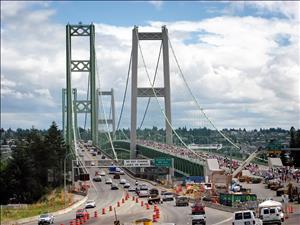On July 12, 1946, Gig Harbor in Pierce County is officially incorporated as a fourth-class town. The Twa-Wal-Kut band of Indians had occupied this snug bay on Puget Sound for centuries and Euro-American settlers had lived there since 1867. Yet, the village of Gig Harbor resists incorporation until after World War II, when residents finally decide they need reliable municipal water, sewer, and fire protection. The vote is 141 in favor of incorporation and 115 against. The town grows substantially after the second Tacoma Narrows Bridge is finished in 1950, putting the town within commuting distance of Tacoma. In the 1970 census, the population will double to 1,657. By 2010, the population will have boomed to 7,126 and this one-time fishing village will become a popular retirement spot and tourist destination.
Around A Pot-Bellied Stove
The incorporation vote took place on June 29, 1946. It was the second incorporation vote -- a previous vote in 1945 narrowly failed. The Pierce County Election Board certified the election results on July 3, 1946, and the Pierce County Commissioners filed an incorporation resolution on July 9, 1946. The state officially declared Gig Harbor incorporated on July 12, 1946.
On the same ballot, voters chose the town's first mayor, Dr. Harold H. Ryan, a prominent dentist, with 101 votes compared to only 37 for his closest competitor. Voters also chose a five-person city council, consisting of grocers Keith Uddenberg and John Finholm, fishermen Emmett Ross and Antone Stanich, and lumber mill owner C. O. Austin. Leander Finholm was elected treasurer.
The city council held its first meetings "around a pot-bellied stove in the GAR Hall," in the Grand Army of the Republic lodge building (Evans, p. 5). The town did not build a town hall until 1965.
A Unified Whole
The fishing village of Gig Harbor had long had two separate business districts. The harbor's west side, originally called Millville, was the center of the town's substantial Croatian fishing community. The head of the harbor, on the north end, had a more Scandinavian character. They had long since grown together into one close-knit community and the new town included both parts of town in a unified whole.
Today the city of Gig Harbor encompasses a six-square-mile area north, south, and west of the harbor.

